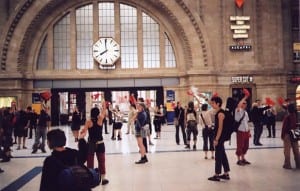After our seminar session in the first week, I began researching into some of the performance works that particularly intrigued and engaged with me. The first performance pieces that distinctly caught my attention was that of using audio in a space which is inhabited by the public on a daily basis and where brief encounters may occur. In a similar sense to that of our SubtleMob experience, two of the performances: LIGNA’s Radio Ballet and Ratozaza’s Etiquette take place in public sites. Firstly, LIGNA’s Radio Ballet, is an ‘exercise in lingering not according to the rules.’ (Ligna Blog, 2009). It took place in a busy Railway Station in Leipzig, Germany; a place in which is under high surveillance by security cameras. With the sites architecture having dark corners and areas to hide in, any act (ie – laying down on the public floor) is deemed outside of the social norms and would result in being removed from the site. Due to its strict control, the Radio Ballet aims to pull various participants together in this site to do various deviant acts of behaviour. On 22nd June 2003, 500 participants ‘usual radio listeners, no dancers or actors – were invited to enter the station, equipped with cheap, portable radios and earphones.’ (ibid, 2009). Using these devices they could listen to a radio program consisting of choreography suggesting permitted and forbidden gestures (to beg, to sit or lie down on the floor etc.). By doing these specific gestures – pulling a stop bell on a train and imitating waving passengers off with a handkerchief, were acts in which made usual passers by stop and take in the unusual action evolving around them.
As seen in the image above, the participants were able to disperse themselves wherever they wished to within the location of the station to thereby let the events play out freely. They acted as ‘a free association, which transformed the coincidental constellation of radio reception into a political intervention.’ (ibid, 2009.) This performance shed a new light upon the busy site and perhaps even united individuals into moments of synchronism.
The second audio performance piece I found mesmerizing was Ratozaza’s ‘Etiquette’. They audience members of a generic public forum such as a cafe/bar are transformed into performance makers.The audio conversation interweaves with the objects placed in front of them; making what would be their everyday ‘small talk’ into a more fun and unique way of public interaction. Etiquette ‘exposes human communication at both its rawest and most delicate and explores the difficulty of turning our thoughts into words we can trust.’ (Etiquette2, 2010). As in the previous performance, the line between audience and performer is blurred – straying from what we see as conventional theatre.
One particular performance that sparked an idea is that of Ezra Dickinson’s concept: Children. During this performance, three adults are filmed walking a certain distance. The performance we as viewers are watching, shows them walking at normal speed with everyone around them at double speed. With this in mind, I interpreted their performance as a metaphor for a child’s mindset: everything is bustling around them and they are the ones who take in the little things that surround us. It is almost a day in the life of a young child and conveying this through the art of slow movements from the performers. It puts forward a question to an audience member of time and what would happen if we slowed this down? People walking by experimented with them – some joining in and some giving them things to hold. The performers could interact but their core was to ultimately walk from one place to another in a straight line. This piece has inspired me to perhaps consider the notion of time and its power to change perspectives and/or movements.
Works Cited:
LIGNA [online blog]. http://ligna.blogspot.co.uk/2009/12/radio-ballet.html [Accessed 7th February 2015].
Etiquette2 [online blog]. http://www.rotozaza.co.uk/etiquette2.html [Accessed 7th February 2015].

